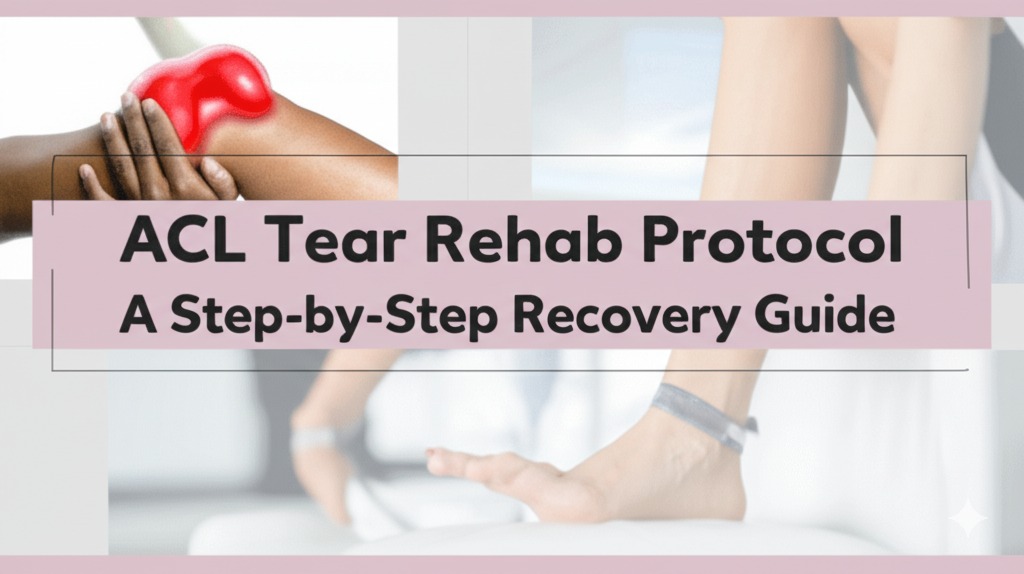An ACL tear is one of the most dreaded injuries for athletes and active individuals. Whether it happens during a high-intensity game or a sudden misstep, the road to recovery can feel daunting. But with a structured rehab protocol, regaining full strength, mobility, and confidence is absolutely possible.
In this article, we’ll walk you through a comprehensive ACL rehab protocol, broken down by phases, so you know exactly what to expect and how to navigate each step of the recovery journey.
What Is the ACL and Why Is It So Important?
The anterior cruciate ligament (ACL) is a key stabilizer in your knee joint. It prevents the shin bone (tibia) from sliding too far forward and keeps the knee stable during cutting, pivoting, and jumping.
An ACL tear—whether partial or complete—often requires surgical reconstruction followed by months of rehabilitation. The success of recovery doesn’t just depend on surgery—it hinges on a strict, well-executed rehab protocol.
The Phases of ACL Rehab Protocol
Rehabilitation typically follows a phase-based approach, with each stage building upon the last. Here’s how the journey is usually structured:
Phase 1: Prehabilitation (Pre-Surgery)
Goal: Reduce swelling, regain range of motion, and strengthen muscles
Before surgery, many doctors recommend “prehab”—physical therapy aimed at improving the knee’s condition beforehand. A strong, flexible knee going into surgery can lead to a faster, more effective recovery.
Key Focus Areas:
- Minimize swelling and inflammation
- Regain full extension and flexion
- Strengthen the quadriceps and hamstrings
- Improve balance and gait
Typical Exercises:
- Heel slides
- Quad sets
- Straight leg raises
- Stationary bike (light resistance)
Phase 2: Post-Surgery (Weeks 1–4)
Goal: Protect the graft, control pain/swelling, and begin early mobilization
This is a critical healing period. The knee is vulnerable, and the newly reconstructed ligament needs time to integrate. But inactivity can be just as harmful—gentle motion and weight-bearing are encouraged (under guidance).
Tips for Success:
- Use crutches and a knee brace as recommended
- Ice regularly to reduce swelling
- Begin gentle range-of-motion exercises
- Gradually increase weight-bearing with physical therapist supervision
Common Exercises:
- Ankle pumps
- Patellar mobilization
- Passive knee extension
- Short arc quads
Phase 3: Strengthening and Range of Motion (Weeks 4–12)
Goal: Restore strength and mobility while avoiding graft stress
This phase is all about progressive loading and careful strengthening. The graft is still healing but can tolerate more activity.
Focus Areas:
- Improve range of motion (ROM) to near full
- Build strength in quads, hamstrings, glutes, and calves
- Start balance and proprioception exercises
- Maintain cardiovascular fitness (stationary biking, pool therapy)
Effective Exercises:
- Mini-squats
- Step-ups
- Leg press (light resistance)
- Balance boards and single-leg stands
Phase 4: Advanced Strengthening and Agility (Weeks 12–20)
Goal: Regain full strength, dynamic stability, and prepare for sport-specific drills
By this point, most patients can walk normally and perform day-to-day tasks. Now it’s time to ramp things up with plyometrics, agility, and functional training.
What to Include:
- Single-leg squats and lunges
- Resistance band exercises
- Lateral movements and jumping drills
- Treadmill running (gradual reintroduction)
Caution: Movements should be closely monitored by a PT to avoid overloading the graft.
Phase 5: Return to Sport (Months 6–9+)
Goal: Safely return to high-level activity with confidence
Returning to sport is a big milestone, but it must be done with objective testing and clearance from your orthopedic surgeon or physical therapist.
Key Criteria:
- Symmetrical strength in both legs
- Good movement mechanics
- No swelling or pain
- Passing functional tests (e.g., hop test, Y-balance)
Suggested Drills:
- Cutting and pivoting
- Sprinting drills
- Sport-specific simulations
- Reaction and coordination training
Tips for a Successful ACL Rehab
A successful recovery isn’t just about following the exercises—it’s about consistency, communication, and mindset.
Best Practices:
- Stick to your rehab schedule – don’t rush or skip phases
- Communicate with your PT and surgeon regularly
- Listen to your body – pain is a signal, not a challenge
- Focus on form over speed or resistance
- Stay motivated with short-term goals
Common Mistakes to Avoid
- Skipping prehab and going straight to surgery
- Returning to sports too early
- Neglecting the opposite leg – both legs need balance
- Ignoring mental health – fear of reinjury is real and valid
Conclusion: Stay the Course and Trust the Process
Recovering from an ACL tear takes time, patience, and effort, but with the right rehab protocol, full recovery is more than possible. Whether you’re an athlete looking to get back in the game or someone aiming to return to daily activity pain-free, sticking to a structured plan is your best path forward.

Kallie Snyder is an author at Stonegate Health Rehab, providing valuable insights, recovery guidance, and rehab resources to help individuals achieve better health and well-being.
